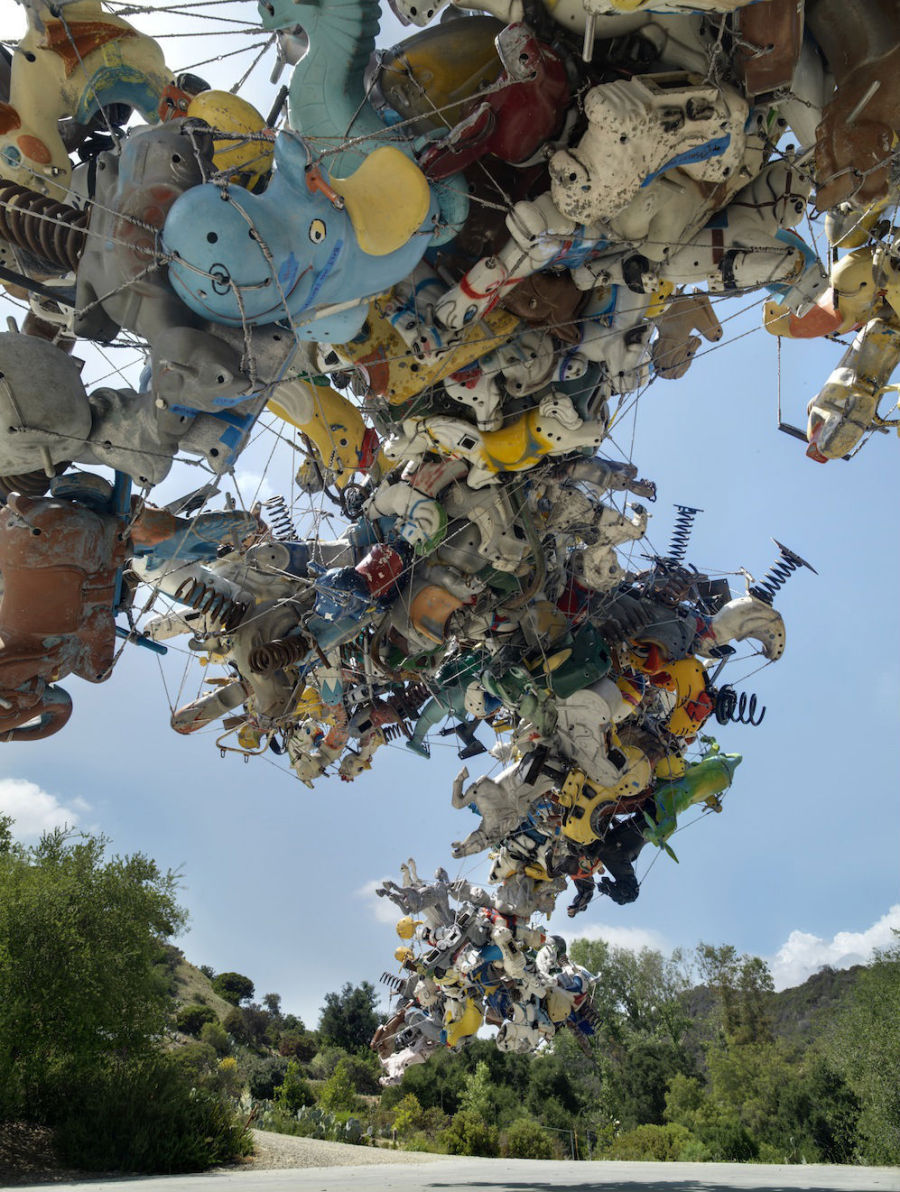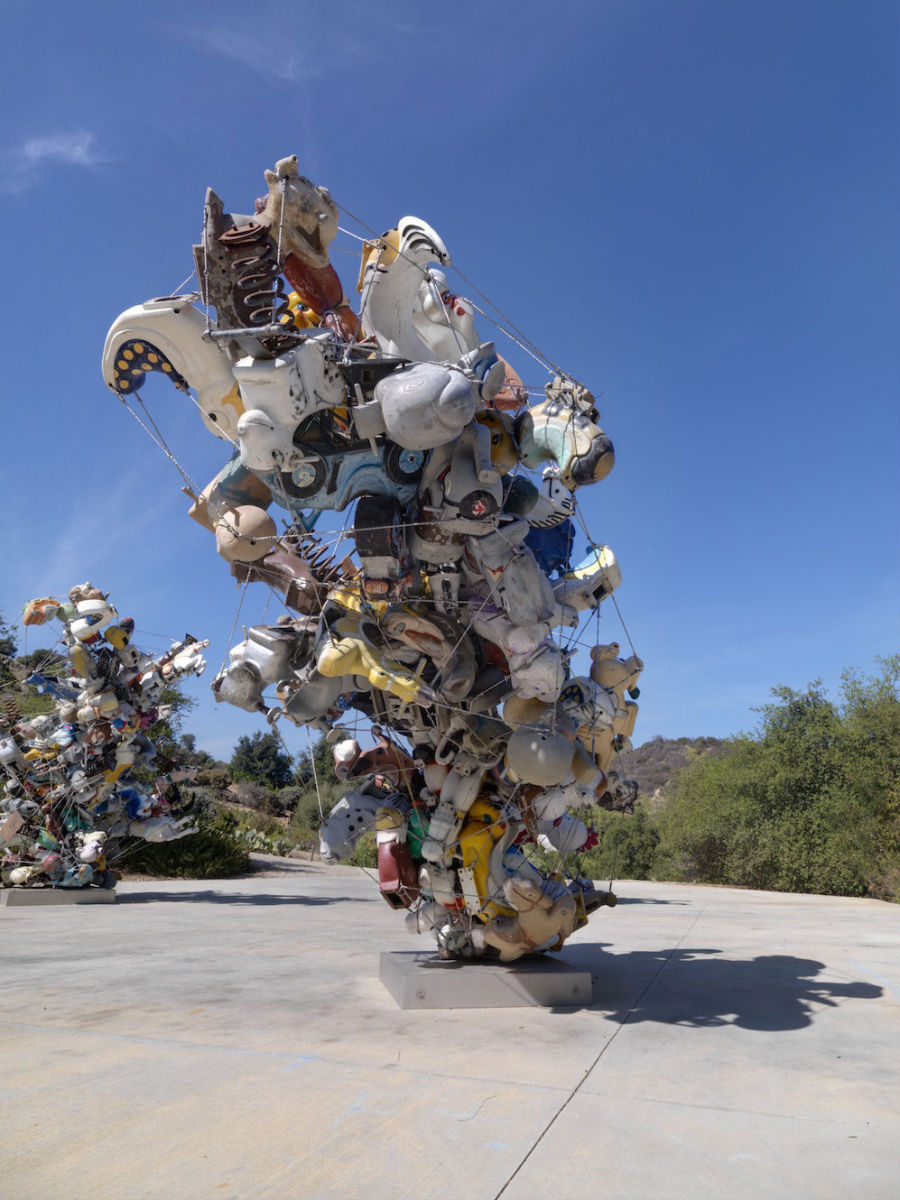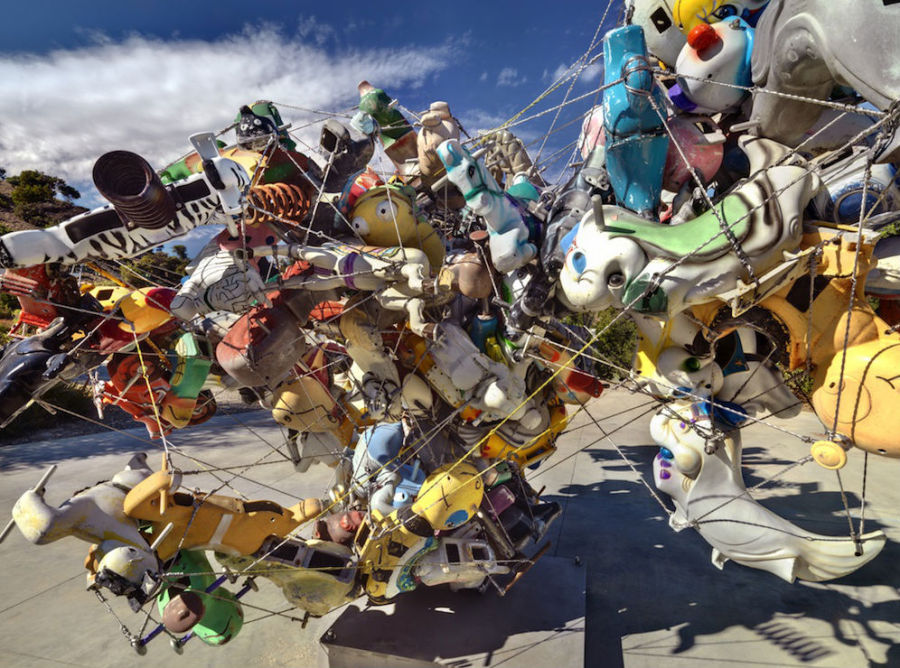In "Our Friend Fluid Metal," Nancy Rubins explodes an abandoned children's playground, sprinkled with thick, aluminum figures of grinning hippos, rideable ponies and wide-eyed giraffes. The metallic beasts, often smiling despite their chipped paint and unveiled innards, appear relatively sturdy and rigid, even when swept into mid-air and left there, hovering in an organic structure bound by strands of heavy wire.
In her first New York exhibition of major sculptures, Rubins presents four gargantuan sculptures made from elements of children's playgrounds made in the late 1940s and early 1950s. The pop eruption resembles a kitsch Noah's arc swept into a hurricane and frozen there by some supernatural force. The force, in this case, is Rubins.

Nancy Rubins, "Our Friend Fluid Metal" (detail), 2014, Aluminum and stainless steel, 204 x 500 x 281 inches, All artwork © Nancy Rubins. Courtesy of the artist and Gagosian Gallery. Photography by Erich Koyama.
"For many sculptures, for many years, I've been working with found airplane parts," the Texas-born, Los Angeles-based artist explained in an interview with The Huffington Post. "There's a gentleman in the desert I used to get a lot of my parts from who just passed away, he was quite elderly. He had mountains and mountains of these airplane parts. And every once and a while the price of aluminum would go up and his mountains would shrink considerably.
"One day, he showed me very proudly a picture of himself in National Geographic with a mobile smelter he had developed after World War II to melt down the airplanes that came back from the war that we had no use for. I realized these little aluminum doodads, these cartoon playground toys, were most likely the melted down fleets of planes. Aluminum was very cheap and it would make sense to make very thick children's playground equipment out of them."

Nancy Rubins, "Our Friend Fluid Metal" (detail), 2014, Aluminum and stainless steel, 204 x 500 x 281 inches, All artwork © Nancy Rubins. Courtesy of the artist and Gagosian Gallery. Photography by Erich Koyama.
The kitsch figures couple a sugary nostalgia with the unnerving aesthetic of the abandoned, as overblown grins turn sour after decades in the sun. Yet underneath their sugary exteriors resides a history too rich to envision. The aluminum used to form each cheery figurine potentially had a previous life as a plane in World War II, and that's just the beginning.
"It's a material that I caught in flux," Rubins explained. "Had I not caught it at this moment they most likely would be on their way to be melted down to the next phase. Even before the airplane parts the aluminum was a part of the earth and before it was part of the earth it was probably parts of stars and meteors and things that slammed into the earth. The aluminum has been around a long, long, long time, longer than I have an imagination for."

Nancy Rubins, "Our Friend Fluid Metal, Paquinto," 2013, Aluminum and stainless steel, 132 x 168 x 96 inches, All artwork © Nancy Rubins. Courtesy of the artist and Gagosian Gallery. Photography by Erich Koyama.
Rubins' massive sculptures resemble, in a way, this possible manifestation of aluminum's past life, resembling an organic, extra-terrestrial structure crash-landing on earth. As Gagosian Gallery describes: "Geological in scope and metastatic in formation, these rhizomatic structures brim with dark energy, pointing to the inexorable proliferation of manmade refuse."
Combining riotous calamity and unexpected elegance, they bear a resemblance to John Chamberlain's lyrical automotive sculptures, if he'd switched to crushing the transportation options of a younger set.
Aside from Chamberlain, Rubins' work echoes the fractured glory of Cubism and the dramatic sweep of the Baroque. Yet the grand, physical gestures of Abstract Expressionism are perhaps closest to Rubins' vision. "When you look at this sculptures, yeah, you're seeing a conglomerate of all these doodads but you're also seeing this highly abstracted thing. I keep thinking of [Willem] de Kooning's paintings and early Philip Guston. These wiggly shapes of color that lock in with another wiggly shape. There's these strange organic forms that go back to the surrealists, or earlier. For me it was a real challenge to take these objects and to transform them."

Nancy Rubins, "Our Friend Fluid Metal, Spiral Ragusso" 2013, Aluminum and stainless steel, 134 x 228 x 127 inches, All artwork © Nancy Rubins. Courtesy of the artist and Gagosian Gallery. Photography by Erich Koyama.
Transform them she does, turning a vintage graveyard into something undeniably living, buzzing with an alien magic that's impossible to pin down. Her use of scrap materials in such massive quantities begs questions of proliferation and waste, yet Rubins is more concerned with the properties of her materials than their environmental associations. "It's more the transient properties," she explained. "We look at these things like a piece of metal or a concrete buildings or things we think are rigid and really they're very fluid in the right circumstance."
Get a glimpse of Rubins' unwieldy metallic clusters above, wonderfully endowed nonsensical titles like "Chunkus
Majoris," "Paquito" and "Spiral Ragusso." The sculptural feats, which took almost two years to complete, collapse any rigid distinctions between power and play, grace and force, rigidity and fluidity. We guess that's what happens when you turn humble scrap materials into a monumental and fantastical organic metal growth.
"Our Friend Fluid Metal" runs from Thursday, July 17 until Saturday, September 13, 2014 at Gagosian Gallery in New York. An opening reception will take place Thursday, July 17th, from 6:00 to 8:00pm.
